As 2024 comes to a close, we're looking back at the year that was. The revolving door of biotechnology continued to spin, with GMOs entering the marketplace and even a few leaving it (adiós, GMO salmon!). Plus, there were important developments in several international and ongoing stories, and a big announcement from us at the Non-GMO Project.
Let's take a look at the year's biggest stories.
GMOs coming in
- Grow your own GMOs — UK's Norfolk Healthy Produce announced in February that seeds for GMO purple tomatoes were available online to home gardeners. The purple tomato is engineered to contain high levels of anthocyanins, and is the first GMO to be marketed to home growers.
- From a land down under — Also in February, a disease-resistance GMO Cavendish banana was approved for cultivation and consumption in Australia and New Zealand.
- It's a plant! It's a pig! It's Piggy Sooy! — In April, the USDA determined Piggy Sooy, a GMO soy plant that produces pork proteins, was not subject to regulation, paving the way for the transporting and planting of seeds. You can find more info about Piggy Sooy and the molecular farming techniques that made it possible in our New GMO Alert.
GMOs going out
- Golden Rice's winding path — In April, the Philippines' Court of Appeals reversed previous approvals for GMO Golden Rice and Bt Eggplant over safety concerns.
- Cultivated meat's ups and downs — After USDA approval of two cultivated meat products from GOOD Meat and Upside Foods last year, the outlook seemed rosy for the fledgeling industry. However, Upside Foods has since initiated two separate rounds of layoffs, and in May, Florida outlawed the manufacture and distribution of "lab-grown" meat in an effort to protect traditional meat producers.
- AquAdvantage goes belly up — In December, AquaBounty announced it was closing its last genetically engineered AquAdvantage salmon production facilities and culling the remaining fish. As the first GMO animal for direct human consumption, AquAdvantage salmon was a controversial product which dozens of major retailers and restaurants pledged not to carry.
- Down with lax GMO rules — On December 3, a federal court struck down rules that eliminated most government oversight of genetically engineered crops, trees and grasses. The overturned rules were implemented in 2020, and essentially allowed the novel industry to self-regulate. The victory was announced by Center for Food Safety, whose lawsuit against the USDA said the rule violated numerous environmental laws and contradicted the agency's previous statements about the need for oversight of GMOs.
EU changes course on new GMOs
Back in 2018, the European Court of Justice decided new GMOs made through new genomic techniques (also known as NGTs) would be regulated using the same framework as older, transgenic GMOs. Last year, the European Commission proposed deregulating NGTs, arguing that the changes made through new genomic techniques could also be achieved naturally or through traditional breeding methods.
The proposal has been criticized for several reasons. Deregulating new GMOs would compromise organic and non-GMO supply chains and compromise a shopper's right to know how their food was made. Aligning new GMOs with conventional breeding and natural processes flies in the face of the Cartagena Protocol's definition of living modified organisms (the EU is a signatory to the treaty). Also, deregulated new GMOs would be eligible for exclusive patents that are off-limits to traditionally-bred or naturally-occurring plants — setting the stage for a corporate takeover of seed breeding in Europe.
A plenary vote in February found compromise by adopting different categories for NGT crops. Category 1 NGTs would be limited to 20 or fewer modifications from the parent plant and would be considered equivalent to conventionally bred plants; Category 2 NGTs with more than 20 modifications would be regulated as GMOs. However, the proposal is currently in legislative limbo following a failure to find agreement at February's vote.
Maize, Monsanto and Mexico
This story first caught our eye in 2020, when Mexico's then-president Andrés Manuel López Obrador issued a decree to ban GMO corn imports and prohibit the herbicide glyphosate. Unsurprisingly, US trade representatives and corn lobbyists vehemently opposed the decree. The US is Mexico's largest trading partner, and 94% of US-grown corn is GMO.
Mexico ultimately softened its stance from a ban to a restriction — allowing GMO corn imports for animal feed or industrial uses but prohibiting it from products for human consumption — and submitted a 264-page document to support the move.
While the US reaction to the potential restriction of GMO corn has been intense and unrelenting, there have been some victories: In June, Monsanto-Bayer (formerly Monsanto, the agrochemical company that developed some of the first GMO crops engineered for tolerance to the herbicide glyphosate) dropped the lawsuit it had filed over the decree. However, in late December, a dispute resolution panel settled the issue in favor of the US.
Mexico's stance as a global leader in food sovereignty expands beyond the GMO corn restriction. In April, Mexico approved historic legislation securing the right to adequate, sustainable, nutritious, safe and culturally appropriate foods. And in October, incoming President Claudia Sheinbaum Pardo's inauguration speech included a pledge to uphold food sovereignty and self-sufficiency, to “feed those who feed us." As a climate scientist and the protege of outgoing President López Obrador, President Sheinbaum intends to uphold the GMO corn restriction and glyphosate ban brought in by her predecessor.
Introducing the Food Integrity Collective
In April, the Non-GMO Project announced the launch of the Food Integrity Collective, an initiative aimed at revolutionizing the retail food system. The Collective's approach encompasses eight essential 'petals' – from minimal processing and non-GMO practices to regenerative sourcing, healthy human communities and animal wellbeing, and includes an initial cohort of partner brands committed to this work. You can find out more about the Food Integrity Collective on the website, here.
Alfalfa might not be a topic that captures the imagination, but this unassuming crop plays a vital role in our food supply. Often overlooked, alfalfa covers more than 15 million acres of US farmland annually, making it the fourth most prevalent crop. In Canada, alfalfa occupies roughly half the acreage. Alfalfa is commonly grown and harvested for livestock feed.
Until the 2000s, alfalfa has been a unique agricultural marvel in that 93% of US-grown alfalfa was produced without herbicides. In our input-heavy industrial agriculture system, that's no small feat. The crop naturally forms dense, tall plants that crowd out weeds, making it remarkably self-sustaining. Farmers typically sow perennial alfalfa seed in their fields only once every five to seven years and between sowings, the crop maintains deep roots that help feed the soil.
Despite the crop's natural ability to suppress weed growth, genetically modified alfalfa engineered for herbicide tolerance entered the market in 2005. If you eat meat, eggs, dairy or honey, alfalfa plays a larger role in your life than you might think.
The GMO alfalfa saga
The decision to produce GMO alfalfa engineered to withstand herbicide might seem like a head-scratcher because GMOs are expensive to develop and this particular crop doesn't generally benefit from herbicides.
GMO alfalfa meets a business need, not a practical one.
After Monsanto had cornered the market for herbicide-tolerant GMOs with "Roundup Ready" GMO corn, soy and cotton, they looked to alfalfa to complete the set. Like the herbicide-tolerant GMOs that came before it, GMO alfalfa was designed to sell more chemicals to farmers.
The regulatory journey of GMO alfalfa was tumultuous. The crop was initially deregulated in 2005, then subject to a planting moratorium in 2007, pending environmental impact studies. The Supreme Court lifted the moratorium in 2010, and by 2011, GMO alfalfa was fully deregulated. Environmental groups continued to sound the alarm, warning that "planting GM[O] alfalfa will result in millions of pounds of toxic herbicides being sprayed in communities where farmers currently use no herbicides at all." The USDA estimated deregulating GMO alfalfa would add 23 million pounds of herbicides to the environment each year. But, the warnings came to no avail. Herbicide-tolerant GMO alfalfa began inching its way across the US landscape, and by 2013, approximately 13% of all US-grown alfalfa was GMO, engineered to withstand herbicide.
In 2014, a new GMO alfalfa variety was unveiled, this one with reduced lignin content to make it more easily digestible to cattle. It's worth noting that low-lignin alfalfa can also be produced through conventional breeding techniques, resulting in a non-GMO version. Because alfalfa is a perennial, and seeds are sowed at five to seven-year intervals, the adoption of GMO alfalfa has been slower than that of other GMOs sowed annually. But, adoption rates are accelerating and the Non-GMO Project Standard considers alfalfa a high-risk crop for the presence of GMOs. (Click here to learn more about the High-Risk List).
Impacts of GMO alfalfa
Herbicide-tolerant GMO alfalfa has significant consequences, such as GMO contamination of wild populations, impacts to non-GMO and organic alfalfa producers and ecological impacts. Alfalfa is easily pollinated by wind and insects, which means pollen with modified DNA can quickly spread to non-GMO and organic fields. As early as 2011, a USDA-ordered study found that 27% of wild alfalfa populations already showed GMO contamination — only six years after GMO alfalfa's initial deregulation.
The spread of GMO alfalfa poses significant challenges for non-GMO and organic farmers. Alfalfa is a robust crop that produces hardy feral populations. Spilled GMO seed can result in "volunteer" plants — believed to be the source of the contamination recorded by USDA 2011 report. Volunteer GMOs can increase contamination risk exponentially, causing a snowball effect. The financial risks of GMO contamination can be devastating to farmers growing non-GMO or organic crops, whose contaminated crop loses non-GMO status and can be rejected from organic and international markets. (Historically, non-GMO growers with contaminated crops have borne the expense of losing market access; the agrochemical companies that produce them are not liable for their spread).
Before deregulating GMO alfalfa, the USDA predicted that glyphosate applications would increase. That was a safe bet, considering that the use of glyphosate, the active ingredient in the herbicide Roundup and the type of herbicide most GMOs are paired with, increased 15-fold in the 20 years after herbicide-tolerant GMOs were introduced. Since the 1990s, advertisements for Roundup have regularly emphasized safety, describing the product as "less toxic than dish detergent" and "won't harm anything but weeds." However, its safety has been called into question. In 2023, researchers from the Global Glyphosate Study shared preliminary new evidence linking glyphosate to cancer at levels that have been considered safe.
Everything is connected

As with many aspects of the food system, the GMO alfalfa issue extends far beyond the fields. Nearly all alfalfa is used for animal feed, which means the animal-derived products at the grocery store rely on alfalfa cultivation. Because the Non-GMO Project Standard prohibits GMOs in livestock feed, looking for the Butterfly on meat, eggs and dairy products helps support non-GMO alfalfa producers.
Our label is also impactful if you eat honey, because alfalfa plays a unique role in its production. Alfalfa produces abundant, nectar-rich flowers, making it an appealing food source for honey bees who gravitate to its purple blossoms. Their activity benefits the farmer, too, improving crop performance, quality and yield. However, glyphosate use threatens this delicate relationship, specifically regarding GMO alfalfa. While glyphosate does not kill a bee outright, it impacts their gut flora, potentially weakening them and making them more susceptible to viruses, mites and other predators. Non-GMO Project Verified honey is sourced from hives without GMOs in the bees' forage area.
GMO alfalfa's circuitous impact on the gut health of honeybees may seem like a stretch, but keep in mind bees are responsible for pollinating an estimated one-third of the food we eat. Ecological systems are complex, and this is the kind of complexity we need to consider to build a regenerative food system.
Toward a non-GMO future
The future of our planet depends on cultivating the ability to view challenges through a wider lens, accepting and embracing their inherent complexity. The concerns around GMO alfalfa are not isolated — they are part of a broader, interconnected ecological and economic system.
Finding meaningful solutions to emerging challenges will require collaboration, scientific rigor and a commitment to sustainable practices. Preserving non-GMO choices, including naturally weed-resistant, non-GMO alfalfa, will help to ensure that future generations have access to diverse, sustainable agricultural options.
What makes for an excellent gift? It's not about a hefty price tag. Great gifts are thoughtful, and they may be helpful or useful. Or perhaps they are decadent, something the person wouldn't have gotten for themself. Excellent gifts express something unique to the recipient.
Food and home-related gifts tap into one of our foundational communal experiences — eating. As we head into the season of renewed bonds and shared meals, we've pulled together a selection of exquisite gifts to delight the taste buds and warm the heart, all from companies that are committed to preserving and building a non-GMO food supply.
The gift of indulgence
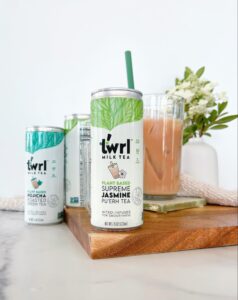
Twrl Tea's holiday gift boxes offer curated selections of canned milk teas and looseleaf tea leaves sourced from organic, multi-generation farms. The gift box includes two flavors of boba, the chewy, bite-sized tapioca pearl that puts the "bubble" in "bubble tea," and a handful of cute branded accessories.
The gift of flavor
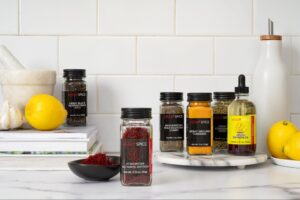
For the gourmet cook on your list, a Heray Spice Gift Box includes some of the world's best saffron, sourced through fair trade practices from farmers in Afghanistan. Wild-grown cumin, coriander, wild caraway and black peppercorn round out the set. Did you know that Heray Spice is a recent Equitable Transfer Fund recipient and a member of the founding brand cohort in the newly launched Food Integrity Collective? You can find out more about this exciting company here.
The gift of care
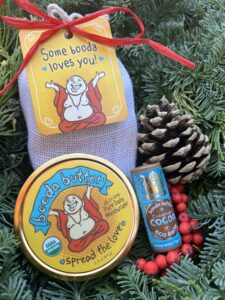
Booda Organics is consistently a staff favorite at the Non-GMO Project — and they're one of our neighbors in beautiful Bellingham, Washington. All of Booda Organics products are crafted from the highest-quality, organic, non-GMO and vegan food-grade ingredients. You can choose from a selection of gift boxes:
- Introduce the Booda Organic line to friends and family with the Booda Butter Eco Gift Bag. Each gift bag contains the three most popular products — moisturizer, 3-in-1 soap and lip balm.
- Their 3-in-1 soap (suitable for bath, shampoo and shave) sets the tone in the Suds of Love Soap Essentials Kit, with a wooden soap rest and scrub sack.
- The Cocoa Lovers Gift Set features moisturizer and lip balm lightly scented with cocoa to "calm the mind and open the heart."
- Or, take the plunge with the Naked Essentials Booda Bundle, a complete set with moisturizer, deodorant, 3-in-1 soap, lip balm and laundry detergent.
The gift of decadence
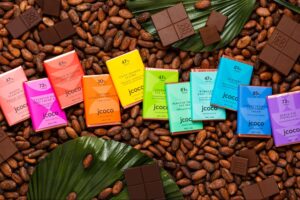
Another Pacific Northwest favorite, Seattle Chocolate, is a woman-owned company committed to fair trade sourcing and empowering women and girls. They offer a range of customizable gift set options, including a dark chocolate collection suitable for vegans. And because the company works with artists from around the world to design some truly beautiful packaging, Seattle Chocolate's products are as gorgeous as they are delicious. We should know! The Non-GMO Project team enjoyed the jcoco Tasting Experience set during an event last winter. Our verdict: Two chocolate-smeared thumbs way, way up.
The gift of skill

This recommendation comes with a warning: Once you start making your own tortillas, you may never be able to go back to store-bought.
Are you shopping for someone with a dedicated Taco Tuesday tradition, ready to level up? Check out Masienda, a retailer on a mission to share heritage, non-GMO maize (crucial work because corn is one of the crops most likely to come from GMOs — find out more in our blog). Masienda helps foodies everywhere explore how powerful this deceptively simple staple can be. The book Masa will educate and inspire, and the tortilla starter kit contains everything they need to make a first meal. Masienda products combine beautiful design with functionality and, above all, joy.
The gift of good taste
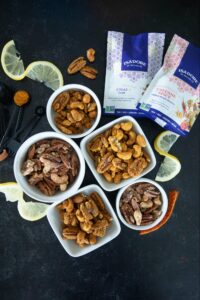
With Isadore Nut Co. gift boxes, healthful and delicious snacks are just the beginning. We recommend the trio of seasonal blends in the festive Gift Box Seasonal Sampler, or the Loving Mixed Nut Gift Tin with a full pound of Isadore's best sellers. Plus, the benefits of this gift go beyond taste: Isadore Nut Co. works to reduce unemployment among adults with disabilities. By working with people of all abilities, Isadore Nut Co. helps underemployed people build skills and supports vital bonds in the community. To learn more about Isadore Nut Co., watch this Instagram live with founder and CEO, Tasya Kelen.
We hope you have the opportunity to come together for some wonderful feasts in the coming weeks. Happy holidays and bon appétit!
Apples joined the Non-GMO Project's High-Risk List in 2022, five years after Okanagan Specialty Fruit's GMO Arctic Apple entered the market. The "high-risk" designation means that GMO versions of a crop or ingredient have become so common in the supply chain that unless a buyer intentionally seeks out non-GMO options, they'd probably end up with the GMO.
Because genetically modified versions of high-risk crops are ubiquitous, the Non-GMO Project Standard requires special scrutiny of high-risk ingredients to ensure they come from non-GMO sources.
As apple trees in the Pacific Northwest, where the Non-GMO Project is headquartered, are heavy with fruit, let's take a look at their GMO counterpart.
All about Arctic
When apples are cut open or bruised, an enzyme called polyphenol oxidase (PPO) causes the apple's flesh to turn brown. Several DIY methods impede browning, including wrapping apples tightly to reduce oxygen exposure or sprinkling the fruit with lemon juice. The developers of the Arctic Apple took another route.
Okanagan Specialty Fruits used a biotechnology technique called RNA interference to "silence" the gene that controls the PPO enzyme. With the gene silenced, the apple doesn't release the enzyme and the fruit doesn't turn brown. Non-browning GMO Arctic Apples are currently available in Golden Delicious, Granny Smith and Fuji varieties, with GMO Gala apples in development.
In the past, Arctic Apples have been available to consumers in two forms: as pre-sliced bags or as a dehydrated apple snack called ApBitz. However, it's unclear if the direct-to-consumer market is still active, since these products were by and large out of stock at the time of writing.
Food service venues such as school cafeterias, restaurants and hospitals could be a more fruitful market for GMO apples. Meals are often prepared well before serving, and a non-browning apple would meet an industry need. However, not all food service venues are interested. Fast food restaurants Wendy's and MacDonald's and baby food giant Gerber have all publicly stated they would not use GMO apples in their operations. (MacDonald's also made a similar pledge when the non-browning GMO potato entered the market).
Are Arctic Apples labeled as GMOs?
Regular readers of this blog know that the federal Bioengineered (BE) Food labeling law requiring mandatory labeling of some GMOs came into full effect in January 2022. Arctic Apples are on the USDA's List of Bioengineered Foods, meaning that BE disclosures — which could appear as a logo, written text or a phone number — would be required on Arctic Apples sold directly to consumers through grocery stores or online shopping services.
However, there's a loophole. The BE labeling law does not require disclosures on bioengineered foods sold or served at food service venues, which are the very places most likely to use non-browning, pre-sliced GMO apples.
To sum up: The venues where Arctic Apples are most likely to be found don't require labeling, and the stores that would require labeling are currently out of stock.
A non-GMO alternative
There are lots of practical reasons to choose non-GMO apples. For example, the selling feature of a GMO Arctic Apple is that it adds convenience to consuming fresh fruit. However, a pre-sliced GMO apple may have been sitting on the shelf for weeks. While it may not have turned brown, it doesn't seem quite right to call it "fresh."
If GMOs don't appeal to you, but the convenience of an apple that won't turn brown does, there is a non-GMO option. The non-browning Opal Apple was created through traditional cross-breeding methods, not biotechnology. It's available in conventionally grown or organic varieties — use the Opal finder to locate a retailer near you that carries them.Opal is an excellent example of a natural, traditionally cross-bred crop with traits comparable to a GMO. And it's not the only one. Other non-GMO wonder-crops include the naturally blight-resistant potato and the dozens of already-purple tomatoes — proving that GMOs are not necessary or wanted, particularly in natural products. With so many non-GMO options, why would anyone choose GMOs?
Non-GMO Project Verified and USDA certified organic are the two most popular clean food labels at the grocery store.1 However, confusion persists about how the two certifications overlap and where they differ. "Is organic non-GMO?" is a common question among shoppers and eaters.
Let's delve into the world of organic and non-GMO foods to understand their similarities and differences — and why they're both crucial for our food system.
Defining organic and non-GMO
USDA certified organic is a holistic certification that covers a wide range of food production practices. It sets rules for how animals are raised, how crops are grown, how pests are managed and more. Organic production excludes the use of synthetic pesticides, chemical fertilizers and genetically modified organisms (GMOs).
Non-GMO Project Verified is a single-issue certification that focuses solely on GMOs. Our definition of GMOs is adapted from an international treaty on biosafety. Working from a clear and comprehensive definition means so-called "new GMOs," including GMOs made from new genomic techniques, are considered GMOs under the Non-GMO Project Standard. Many of these are entering the market unlabeled and unregulated.
In short, while both certifications exclude GMOs, they approach this goal from different angles — a targeted approach for the Non-GMO Project and a holistic one for USDA organic. Also, the two programs use distinct tools and methods to accomplish their aims.
The following table compares Non-GMO Project Verified and USDA certified organic and outlines the key similarities and differences between the two.
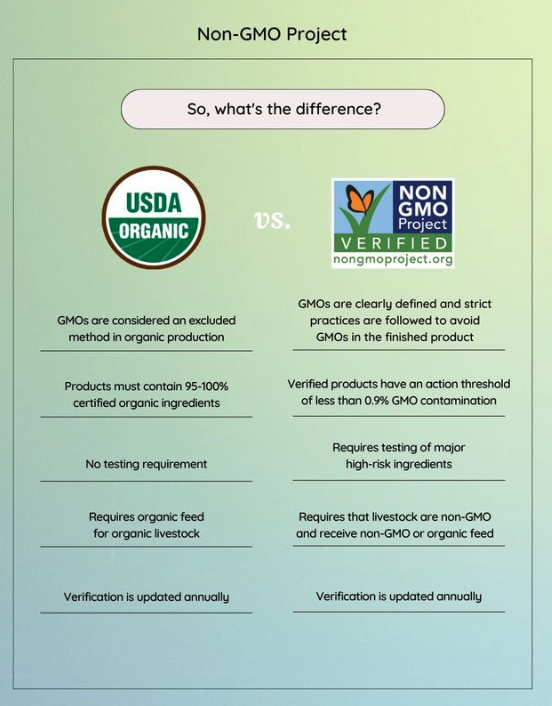
The Non-GMO Project clearly defines GMOs and requires testing of major, high-risk ingredients. By contrast, organic does not require testing; products must contain 95-100% certified organic ingredients. USDA organic requires organic feed for certified livestock, while Non-GMO Project Verified requires that livestock are non-GMO and their feed is non-GMO or organic. Both certifications must be renewed annually.
How the programs work
Organic certification and Non-GMO Project verification are two very different processes, from the administrative bodies in charge to what's eligible for certification.
Organic certification is a federal program overseen by the Department of Agriculture (USDA) in the United States and by the Canadian Food Inspection Agency (CFIA) in Canada. To gain organic certification, farmers must develop and implement an "organic system plan" that covers a range of practices, such as preserving soil health, crop rotations, pest management and livestock care. Farmers seeking organic certification must abstain from non-organic product practices — including synthetic fertilizers, pesticides, and GMOs — for three years before their operations may be considered organic.
Non-GMO Project verification is a third-party certification administered by a nonprofit organization. Food and personal care products that are in compliance with the Non-GMO Project Standard are eligible for verification; brands, farms or processing facilities are not. Product evaluation includes measures such as supply chain segregation and testing of major high-risk ingredients to ensure compliance. Because products are evaluated one by one, there is no transition period for producers.
Testing: a fundamental difference

One of the most significant differences between these certifications is their approach to testing. The Non-GMO Project requires testing for all major, testable, high-risk ingredients to ensure they come from non-GMO sources. The Project requires legally binding documentation, such as affidavits for untestable high-risk ingredients.
In contrast, the National Organic Program does not require testing for GMOs. GMOs are considered an "excluded method" under organic regulations, but no mechanisms exist to detect or address contamination. The phrase "organic is always non-GMO" is based on the idea that a producer, having followed their organic system plan, will not have used GMOs. However, this doesn't account for accidental contamination.
The reality of GMO contamination

Once genetically modified organisms are released into the environment, they cannot be recalled, and containment of GMO crops has been a persistent problem. Pollen from GMO crops is carried by wind or wildlife, potentially contaminating non-GMO and organic crops and their wild relatives. The Non-GMO Project's testing requirement is crucial to protecting the non-GMO food supply because of the risk of GMO contamination.
Contamination can spell disaster for farmers and manufacturers whose livelihoods depend on avoiding GMOs. If their products are Non-GMO Project Verified or certified organic, or if they are selling in foreign markets where GMOs are restricted or banned, GMO contamination can put them out of business.
Sadly, contamination is all too common. A 2014 survey of organic producers found that a third of respondents had dealt with GMO contamination on their farms, and more than half of those who experienced contamination had their goods rejected by buyers for that reason. The potential financial losses caused by GMO contamination have pushed some farmers away from organic production altogether.
What's an "action threshold"?
An "action threshold" is a metric used to evaluate test results. Action thresholds reflect the complexity of the supply chain and the reality of GMO contamination, helping to make our Standard meaningful and achievable. They are crucial to strong certifications because they protect the program's integrity by helping participants identify and correct contamination events.
An action threshold is not a GMO allowance. The action threshold for contamination in Non-GMO Project Verified products is 0.9%, which is the same level that triggers mandatory labeling in the EU.
However, USDA organic certification does not indicate action thresholds for contamination by GMOs. This makes sense under a process-based organic certification, which does not require testing.
Emerging GMO technologies
Genetic engineering is evolving quickly. Products made from new techniques, including gene editing, synthetic biology and molecular farming, are entering the marketplace unlabeled and unregulated, posing new risks to organic and non-GMO producers. The Non-GMO Project Product Verification Program keeps pace with the latest GMO technologies by clearly defining and testing major, high-risk ingredients and monitoring industry developments.
As a federal program, organic certification may be slower to adapt to rapid developments. For example, in 2018 and 2019, the National Organic Standards Board recommended changes and updates to the language used for GMOs, but the proposed changes have yet to be integrated.
How non-GMO supports organic
Far from being competitors, Non-GMO Project verification and organic certification complement each other in several ways:
- Non-GMO as a stepping stone — Non-GMO Project verification can serve as an on-ramp to organic farming. It's often one of the first steps producers take when transitioning to organic.
- Financial support during transition — Non-GMO farming can provide a market for farmers transitioning to organic production, helping to offset the financial burden of a 3 to 4-year transition period.
- Reduced contamination risk — Non-GMO farming practices in surrounding areas can create a buffer zone for organic farms, reducing the risk of GMO contamination.
- Supply chain support — The Non-GMO Project's work helps expand access to non-GMO ingredients and increases traceability throughout the supply chain.
The gold standard: organic and non-GMO
While each certification provides valuable insights into food production, many consider the combination of USDA organic certification and Non-GMO Project verification to be the gold standard for food. This combination assures shoppers and eaters of holistic, sustainable farming practices along with rigorous GMO avoidance and testing.
Research shows that products displaying both Non-GMO Project Verified and USDA organic labels are more popular than comparable products with one label or the other. This reflects consumers' desire for food that meets the highest standards of GMO avoidance and holistic agriculture modeled on natural systems.
Both USDA certified organic and Non-GMO Project Verified play crucial roles in our food system. While organic certification offers a roadmap for agriculture based on natural systems, Non-GMO Project verification provides the rigorous testing and monitoring necessary to ensure GMO avoidance in an increasingly complex biotechnology landscape.
Whether you choose organic, non-GMO — or both — you support a cleaner, more transparent food supply for all.
1 Who Is the Natural Shopper in 2024?
Agriculture does a lot for us. It produces food, fiber and fuel. In many places, it's critical to social bonds and community. Plus, the land itself provides valuable ecosystem services, protecting the environment we need to thrive.
That's why it's vital that our food systems are healthy, because a healthy food system sows the seeds for true health — for people and the planet. By contrast, extractive agriculture practices causes serious problems down the road. They take from the earth without giving back, produce nutrient poor food and pollute the environment.
Food that's better for you starts with food that's better for the planet.
A non-GMO food system that preserves and builds our genetic inheritance is essential to ecological harmony, abundant biodiversity and environmental wellbeing. Here are six compelling ways non-GMO supports a healthier planet — and a healthier you!
- Healthy soil = healthy people — GMO-based agriculture is associated with destructive practices such as increased pesticide use and suppressed crop diversity. When the range of crops and organisms is reduced, we lose the resources and resilience biodiversity provides. A prime example is right in the soil: Did you know healthy soil is linked to increased nutrition in our food, and that soil organisms produce valuable medicines? It's true! The more microorganisms, and the more different types of microorganisms, the better.
- Disrupt the monopoly — GMOs and other patented crops place a huge amount of power in the hands of corporations, creating monopolies that stifle innovation. Corporations use natural resources to do what corporations do best: make money. Meanwhile, private ownership of the food supply doesn't actually feed the world — small farmers do that! And they do it while protecting millions of plant species. Growing a vibrant, adaptive and healthy food system means saying no to GMOs — and the corporate power that produces them.
- Look locally — Community Sustainable Agriculture programs, or CSAs, are a great way to support your local farmers while enjoying some of the freshest and bestest produce around. CSAs help you participate in a regional food system and invest in the local economy. Farmers who grow non-GMO are able to save seeds, producing varieties that are well-adapted to the local climate. In the end, non-GMO and locally adapted seeds leave a legacy of resilient crops for future generations.
- The diverse diet — For decades, nutritionists have recommended a diverse diet, low in processed foods. We agree, and would add that most processed foods are made with GMOs (another reason to look for the Butterfly). GMO-derived ingredients come from a shallow pool of dietary options, and staple crops like corn and soy are overrepresented on ingredient panels (more than 90% of the corn and soy grown in the U.S. is GMO). People need a much wider range of food sources than GMOs can deliver. Choose whole, seasonal foods as often as possible, and make a habit of trying something new in the produce aisle.
- Non-GMO protects organic — Transitioning to organic farming is a big commitment. It takes three years for most farmland and during that time, non-GMO crops can help support farmers by supplying a market for their crops. Non-GMO acreage and supply chains also protect organic farms and processing facilities by reducing the risk of contamination. After all, one of the reasons the Non-GMO Project was founded was to support USDA organic certification with a tested and traced non-GMO supply chain.
- The gold standard: Organic + Non-GMO Project Verified — A 2022 study from France found that most people have been exposed to the weedkiller glyphosate. Since "Roundup Ready" GMOs (engineered to withstand glyphosate) were introduced in 1996, use of the controversial weedkiller has increased 15 fold, with negative impacts on species biodiversity. How do we cut back on chemical inputs in agriculture? To reduce glyphosate on the landscape, grow non-GMO; to dodge glyphosate on your plate, look for organic!
There's an essential reciprocity at work in our dealings with the earth. Take care of your home and it will take care of you. Or, to put it another way: In the food system, the "give" and "take" are forever intermingled. The best outcomes start with embracing this dynamic, and leveling up.
The plant-based movement has been on quite a journey recently.
Plant-based foods have been growing in popularity for decades. Moving from niche products found almost exclusively at health food stores, plant-based staples now occupy dedicated sections in mainstream grocers around the world.
Then, in just five years, the US market for plant-based products more than doubled, growing from an estimated $3.9 billion in 2017 to $8 billion in 2022. What happened, you may well ask, to propel the industry to new heights? It was the intersection of two powerful forces.
The first was the development of a new generation of plant-based products designed to replicate the taste and texture of animal-derived foods. The second was a global pandemic that disrupted supply chains and propelled personal health to the forefront of many eaters' minds. The combination incentivized carnivores and omnivores to flock to plant-based like never before.
While the plant-based market's trajectory has since leveled off, the need to embrace alternative proteins persists. On a warming planet with limited resources, our planetary and personal health are intertwined.
What is the role of genetically modified organisms in building a plant-based future? Does genetic engineering support the movement's growth or compromise the very principles that inspired it in the first place?

What are plant-based foods?
Technically, a plant-based food is any food that comes from — you guessed it — a plant. However, we're speaking more specifically than that. As we think of the term, plant-based foods are food options that come from plants and provide a good source of protein, a quality many consider synonymous with animal-derived foods such as meat, dairy and eggs.
Traditional plant-based options, such as tofu, tempeh, legumes or protein-rich grains like quinoa, have been eaten around the globe for centuries. In fact, plant-based foods' popularity builds on a long history of plant-based eating in many communities of color. A 2019 Gallup poll found that flexitarian diets with reduced meat intake were particularly prevalent in non-white communities.
Along with traditional plant-based eating, higher adoption of plant-based diets among communities of color can have many driving forces. The following possibilities are by no means exhaustive:
- Self-care — People of color are disproportionately impacted by many chronic diet-related diseases, such as diabetes, high blood pressure, obesity and cancer, conditions which may respond to plant-based diets.
- Dietary restrictions — An estimated 68% of people around the world, predominantly people with Asian, Indigenous and African heritage, are lactose intolerant, meaning they cannot digest the sugars found in dairy products.
- Social justice — Social justice work and veganism share ethical foundations, according to activist and writer Dick Gregory, resulting in common ground that has made plant-based diets popular among activists and people from marginalized groups.
To learn more about the intersection of plant-based foods, social justice and race, we recommend exploring original content and first-hand accounts, such as Radical Veganism and White Supremacy and Veganism on Instagram, and Ralinda Watts' excellent piece from 2021, How Veganism Is Rooted in Black Activism, and Why It Isn't Just For White People.
The rise of plant-based
During the last decade, the variety and adaptability of plant-based products proliferated. A new generation of plant-based products that recreate the experience of eating animal-derived foods entered the market. Today, plant-based options are available at every grocery store and integrated into the meat department alongside traditional products.
People seek out plant-based products for a range of reasons, including the following:
- Health concerns — Studies have linked red and processed meat consumption to increased risks of heart disease, diabetes, and cancer. Allergies and food sensitivities can also influence choice.
- Environmental concerns — Choosing plant-based options can reduce our ecological footprint.
- Ethical considerations — Industrial animal farming operations are often brutal for the animals raised there and dangerous for the workers. Consumers seek out plant-based products as a moral and socially responsible alternative.
Where can GMOs show up in plant-based?
While many brands are embracing non-GMO innovation to create delicious and natural plant-based products, others are relying on biotechnology for base ingredients. Here are some of the most common sources of GMO ingredients:
- Traditional GMO crops — Soy is a common base ingredient for plant-based foods. With most of the soy in the US coming from GMOs, there's a pretty good chance that plant-based products derived from soy are GMOs unless the product is organic or Non-GMO Project Verified.
- Gene-edited crops — Unlike traditional GMOs, which involve inserting genes from different species into a target crop, gene editing techniques like CRISPR are used to make changes within a plant's existing genome.
- Synthetic biology —"Synbio" ingredients are created using genetically modified microorganisms such as yeast, bacteria or algae to produce compounds used in food manufacturing. Synbio ingredients can appear as animal-free proteins, fats, flavorings, colorants and other additives.
- Molecular farming — This is the genetic engineering of plants to exploit them for use as factories to create novel compounds. For example, several molecular farming projects we are following involve inserting animal DNA into a genetically engineered plant so the plant produces animal proteins.
Why plant-based is better with the Butterfly
GMOs are novel organisms that have never before been part of the human diet. Without long-term, independent feeding studies, the potential health impacts of GMOs are unknown.
In the grocery store, shoppers may not be able to tell which products are made with GMOs. The USDA's Bioengineered Food Labeling law allows highly processed products and many products made with new GMOs to go unlabeled. Synbio ingredients that utilize animal DNA as part of the genetic engineering process may appear in products marketed toward vegans, even if the use of animal tissue doesn't align with vegan values.
GMOs are often touted as a climate solution, but these claims can be misleading or difficult to substantiate. It's unclear how much benefit energy-intensive synbio or chemical-intensive GMO monocrops offer when compared with industrialized GHG-producing animal farming. Some new GMOs perpetuate industrial agriculture practices that harm ecosystems and biodiversity (think: synbio ingredients that rely on GMO soy or corn as feedstock for the genetically modified microorganisms).
The future of plant-based
While the expansion of plant-based products appears to have slowed, the product category is absolutely here to stay. More than 60% of households regularly choose plant-based products, and over ¾ of those folks plan to do so again — reducing our consumption of animal products and improving our health and the planet's health, to boot.
However, the plant-based movement is at a crossroads. Will the values of sustainability and health guide the future of plant-based, or will it rely on energy-intensive tech, destructive industrial practices and headline-grabbing hyperboles? The debate is ongoing.
Thankfully, GMOs are not an essential ingredient in plant-based foods. Many brands are exploring non-GMO innovation to develop new plant-based products. The Non-GMO Project Verified mark is on more than 2,000 plant-based options made without genetic engineering — you can browse the Dairy Alternative and Meat Alternative selections in our Product Finder. These companies are committed to bringing new products to market that uphold the values and traditions of the plant-based movement. They use natural ingredients such as non-GMO nuts, grains and legumes as the basis of delicious milks, creamers, cheeses and frozen desserts. Legume-based non-GMO egg replacements scramble like the real thing and plant-based meat alternatives can take the place of seafood, sausage and even burgers.
The growth of the plant-based movement offers tremendous potential for improving human health, reducing GHG emissions and creating a more equitable and sustainable food system. However, realizing this potential requires vigilance against silver-bullet solutions and unsustainable biotech fixes that may undermine these goals.
The Non-GMO Project believes that plant-based food is essential to a regenerative and nourishing food system and that the brightest future stays true to the movement's roots in the natural foods space. Our vision includes:
- Transparency — Accurate food labeling should support your right to know how your food is made.
- Accountability — Full-life-cycle accounting of the impacts of new GMOs in plant-based products.
- Regeneration — Holistic, non-GMO farming practices protect biodiversity and soil health and improve nutrient density.
We are at a critical time, both for people and the planet. The most powerful tool we have is our ability to make informed choices.
Everyone should be able to enjoy delicious alternatives to animal-derived foods that stay true to the core values of sustainability, health and social justice. By supporting non-GMO innovation in plant-based foods, asking about ingredient sourcing and supporting brands that align with their values, shoppers can help steer the plant-based industry towards a more sustainable and equitable future.
Look for the Butterfly – the Non-GMO Project verification mark – to ensure your plant-based choices are truly rooted in nature.
Here comes the school year! And with it, the creative challenge of what to put in your kids' lunchboxes. Day after day. For the next ten months, give or take. It's no wonder many caregivers struggle to come up with fresh combos of healthy, tasty meals that travel well.
We've got fresh ideas and hot tools to help you avoid GMOs in your kids' lunchboxes.
#1 — Choose ingredients that are low risk for containing GMOs
A simple way of keeping GMOs out of your child's lunchbox is to center meal planning around ingredients that are not considered high-risk. (Risk status is based on the likelihood a crop or ingredient comes from a GMO source — you can find out more here).
For example, chickpeas are a low-risk crop that's both delicious and versatile. Make them a lunch centerpiece with falafels, or add a side of hummus and veggies. You can also roast them for a satisfying standalone snack.
Or, trade potatoes, which are on the High-Risk List, for sweet potatoes which are low-risk. Fries or fritters made from sweet potatoes are nutritious, great tasting and pair well with a variety of dipping sauces. Here's another pro tip: Popcorn is naturally resistant to GMO contamination and not on the high-risk list. So, instead of chips made from high-risk corn, go for popcorn.
#2 — Explore plant-based options
A lot of GMO soy, corn and cottonseed ends up in animal feed, making meat, eggs and dairy important places to choose non-GMO. Substitute plant-based protein alternatives whenever possible or look for the Butterfly on animal-derived products (we'll explore that further below) to vote with your dollars for a non-GMO food supply.
If you're curious about plant-based, or just plain hungry, the folks behind Veganuary offer a wealth of ideas and recipes through this Vegan School Lunch Challenge website. Plus, Veg News published a bunch of kid-approved vegan lunch options that can be adapted for a non-GMO lifestyle by replacing high-risk corn products and wheat (which is currently on the monitored risk list) with low-risk alternatives or Non-GMO Project Verified and USDA organic options (think: Verified or organic tortillas, breads and pasta, or products made from alternative flours like rice, lentil or quinoa).
#3 — Use our produce guide
Adding a piece of fruit or some cut veggies to your kid's lunch is one of the best ways to jump-start healthy habits. However, the biotechnology industry has a growing interest in GMO fruits and veggies that could sneak into a lunch box (for example, pre-cut GMO apple slices that are engineered to resist browning).
Under current regulations, many new GMOs made from emerging techniques such as gene editing won't be labeled. That's where we come in. Check out our produce guide for help identifying GMO fruits and vegetables currently on the market, as well as a rundown of those in development.
Remember: If the apple won't brown, put it down. If the pineapple is pink, stop and think.
#4 — Look for the Butterfly
Of course, the most important thing you can do is look for the Butterfly. Choosing Non-GMO Project Verified products gives you access to more lunchtime options and helps support the farmers and ranchers growing food without GMOs. That's a win-win.
For example, how is a quesadilla made with low-risk ingredients different from one made with Non-GMO Project Verified ingredients? The low-risk version might feature tortillas made with lentils, stuffed with a vegan cheese made from nut milks. If you look for the Butterfly, you could use corn or flour tortillas and be confident they were made with non-GMO corn or wheat. If you're still interested in plant-based, Verified soy-based cheese will be made from non-GMO soybeans. Or, cheese made from traditional dairy will come from livestock that were not fed GMOs.
Looking for the Butterfly opens up a whole world of possibilities while helping to preserve the non-GMO food supply. Bring on the school year!
This blog was originally published on August 28, 2022 and has since been updated.
In 1992, the USDA approved the first genetically modified crop. Since then, technology has evolved quickly to include a range of new GMO techniques that outpaced existing regulation. Today, products made from these new techniques are hitting grocery store shelves near you.
The early GMO landscape was sparsely populated. A few major agrochemical corporations led the work of inserting foreign DNA into commodity crops such as soy, corn and cotton. The resulting GMOs were mostly engineered to withstand weedkillers or to produce their own insecticide.
New GMOs are a different story, engineered for a broad spectrum of traits. New techniques are often cheaper and more accessible than traditional methods, with names you may recognize from news stories (i.e., CRISPR and TALEN gene editing, gene silencing and RNAi, and the chameleon-like synthetic biology). Generous venture capital funding is driving experimentation, fueling a dramatic increase in the number of companies acting in this space. Also, new GMOs don't necessarily contain foreign DNA in the finished product, which allows them a shorter path to market and bypasses established regulation. In the US, Bioengineered (BE) Food labeling laws fail to address many products of new techniques, leaving shoppers in the dark about whether or not there are new GMOs in their grocery cart.
Products made from new GMOs are showing up in virtually every aisle in the grocery store.
Synbio — from livestock to labs
Synthetic biology offers cheap and easy access to synthetic flavors, colors, fragrances, proteins, fats and more. Sybio can even convert plastic waste into vanilla flavoring. (At the Non-GMO Project, we're firm believers in waste reduction. But our enthusiasm stops short of eating plastic.) Cosmetics and body care products are incorporating synbio ingredients such as synthetic human collagen and spider silk proteins, and synthetic vitamin compounds are appearing in synbio supplements.
Synbio allows manufacturers to source many different compounds by programming genetically engineered microbes to convert a cheap ingredient into something they need. It's the ultimate low-rent alchemy.
GMO-based protein alternatives and animal-derived products, in particular, are booming. Raising livestock is resource-intensive, and industrial livestock farming can be famously destructive to the environment. Synthetic versions of animal-derived foods are all the rage.
One of the best-known GMO products in this category, the Impossible Burger, is made with GMO soy and the unique synbio "heme" that gives it blood-like juices and general "meatiness." The regulation and approval of heme has been contentious, with environmental groups advocating for a rigorous evaluation of this novel substance. However, regulatory bodies have been accommodating towards Impossible Foods. For example, when the Impossible Burger was first offered in restaurants in 2016, the FDA had not yet completed its assessment or approval of the product's safety and neither the company nor the FDA made the public aware of this fact.
New GMO techniques are also being used to genetically modify animals, and the meat has been approved for human consumption. A genetically modified pig was engineered by inserting human DNA and deleting a portion of the pig's DNA to create organs and tissue for medical uses that would be more acceptable to a human recipient. The pig has since been approved for both human consumption and for medical uses.
What happens when technology outpaces regulation?
GMOs have traditionally been created by inserting foreign DNA into an organism, which uses a type of bacteria that is considered a plant pest. To control the GMO's potential to become a plant pest, the USDA's Animal and Plant Health Inspection Department (APHIS) has held the responsibility of regulating traditional GMOs. To be clear, APHIS regulation deals only with the GMO's potential to be a plant pest; it does not assess the crop's safety as part of the human food supply.
With new GMOs made from emerging techniques, the resulting organisms don't necessarily contain foreign DNA. Gene-editing techniques, for example, can modify genetic material within an organism, and synbio uses genetically engineered microbes to create new compounds through fermentation.
With technology outpacing regulation, new GMOs are not subject to sufficient oversight. When that happens, stuff can fall through the cracks. In the case of new GMOs, an entire bull nearly fell through the cracks.
In 2015, a pair of hornless bulls were born, created using the gene editing tool TALEN. A few years later, an FDA bioinformatician found a sequence of non-bovine DNA in the genome of one of the bulls, presumably from contamination during the editing process. It's important to note that the discovery of the non-bovine DNA was entirely accidental. It wasn't detected by the bull's developers, but by an external agency working on a routine data check. It's unknown exactly what impact, if any, that DNA sequence might have had, but that's the point of regulation — to mitigate the risks of new and novel creations.
This story illustrates the problem of not knowing what to look for: Had the FDA scientist randomly selected another data set for analysis, the non-bovine DNA would likely not have been discovered. Marching boldly into unknown territory, where guardrails have yet to be built because it is unknown territory, is extremely reckless.
Off-target effects and unintended consequences
New GMO techniques have been described in blushing terms, including "the future of food" and "precise, fast and inexpensive" — language that reflects the theory. The reality includes a pattern of unexpected outcomes that bring such optimism into question.
Let's look at gene editing, a new GMO technique that is widely heralded for its precision. However, that precision depends on cutting a DNA strand at a specific spot and nowhere else. In practice, edits occurring at locations other than the intended target are quite common. They are called "off-target effects," and they can interfere with the normal functioning of genes which can cause serious problems, such as mutations, disease, allergens or toxins.
Even when the cut is made at the correct spot, the outcome can still be unpredictable because of the complexity of how genes work. A single gene can be involved in several different and seemingly unrelated functions. Our understanding of how genes work is growing, but it's still limited. We see that play out in the narratives of some gene-editing experiments.
For example, a few years ago scientists were working to engineer a bull who would produce predominantly male offspring — a benefit in the beef industry because males convert energy into muscle mass more efficiently than females do. Looking for a section of DNA in the bovine genome where they could make a cut and insert genetic material without disrupting the necessary functions, they found what they thought was a promising section of "blank" DNA. However, once edits were made to that spot, the embryos died. Its function was unknown, but not unimportant.
According to Grist, "It was only blank because it was unexplored." In some as-yet-undiscovered way, that blank section of DNA was critical to the life of the growing organism.
Advertising the next generation of GMOs
The gulf between traditional and new GMOs affects more than regulation. Biotech developers are also exploiting it for marketing. The negative public perception of GMOs is widely known — most shoppers are aware of the GMO issue, and many choose to avoid GMOs at the store. Some brands are trying to distance themselves from those negative associations, marketing new GMOs as "non-GMO," even while relying on biotechnology to create novel products.
In their FAQs, Perfect Day — developers of synbio animal whey protein and the vegan ice cream it's made with — poses the question, "Does your protein contain GMOs?"
They provide this answer: "No, animal-free protein does not contain GMOs…. Genetic engineering is part of our process, but genetically modified organisms or any detectable genetic material is not present in our protein."
The response seems carefully crafted to focus on the absence of genetically modified DNA in the finished product and minimize the role of genetic engineering in the product's creation.
To avoid GMOs, look for the Butterfly!
New products made with emerging techniques are entering the market across categories, and most new GMOs are unregulated and unlabeled.
The Non-GMO Project monitors new biotech developments as well as their commercial availability so you don't have to. Our dedicated research team has seen a dramatic increase in the number of biotechnology developers — the number of companies we’re monitoring has grown nearly more than 300% in the last 5 years.
While the USDA's Bioengineered (BE) Food labeling law requires disclosures on some GMO products, it is not comprehensive. New GMOs in particular risk being overlooked because the law requires detectible modified genetic material in the finished product to trigger mandatory labeling. Products made from new techniques don't necessarily leave modified material behind, and some new GMOs are currently untestable.
New GMOs threaten the natural products industry and the movement toward regenerative agriculture in part because they are often marketed as "natural" or given dubious sustainability claims. For us folks at the Non-GMO Project, new GMOs inspire an eerie sense of déja vu — traditional GMOs entered the market 30 years ago with some of the same promises.
In the absence of meaningful regulation and reliable labeling, the work we do at the Non-GMO Project is more important than ever. Through our rigorous and evolving Standard and the continuous research that informs it, we support your right to choose whether or not to consume GMOs.
